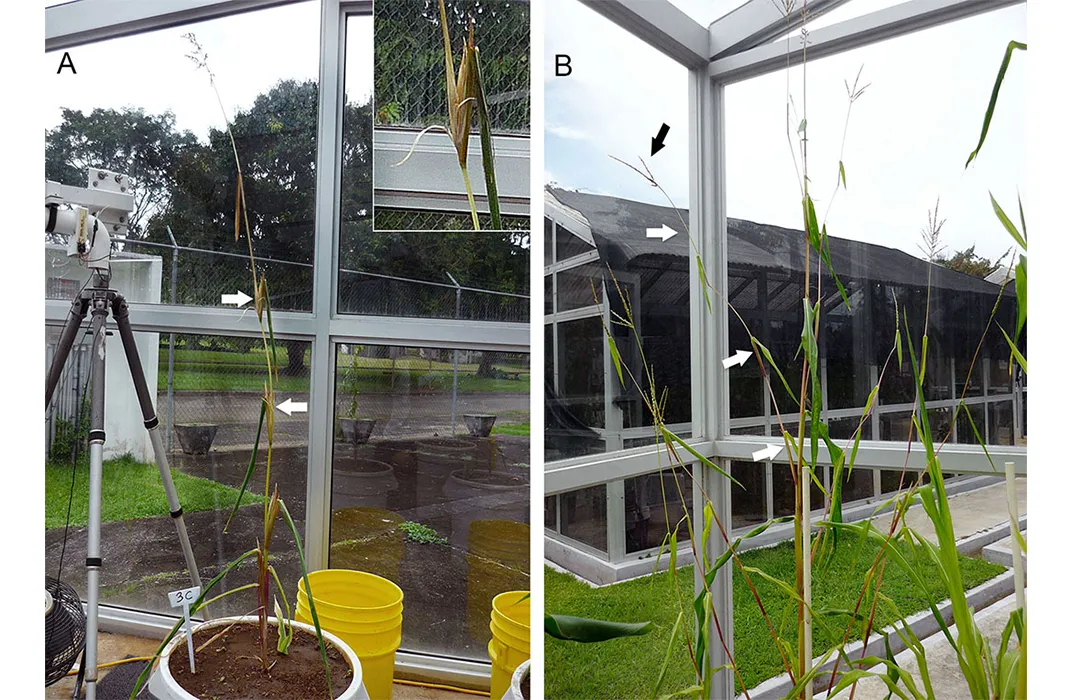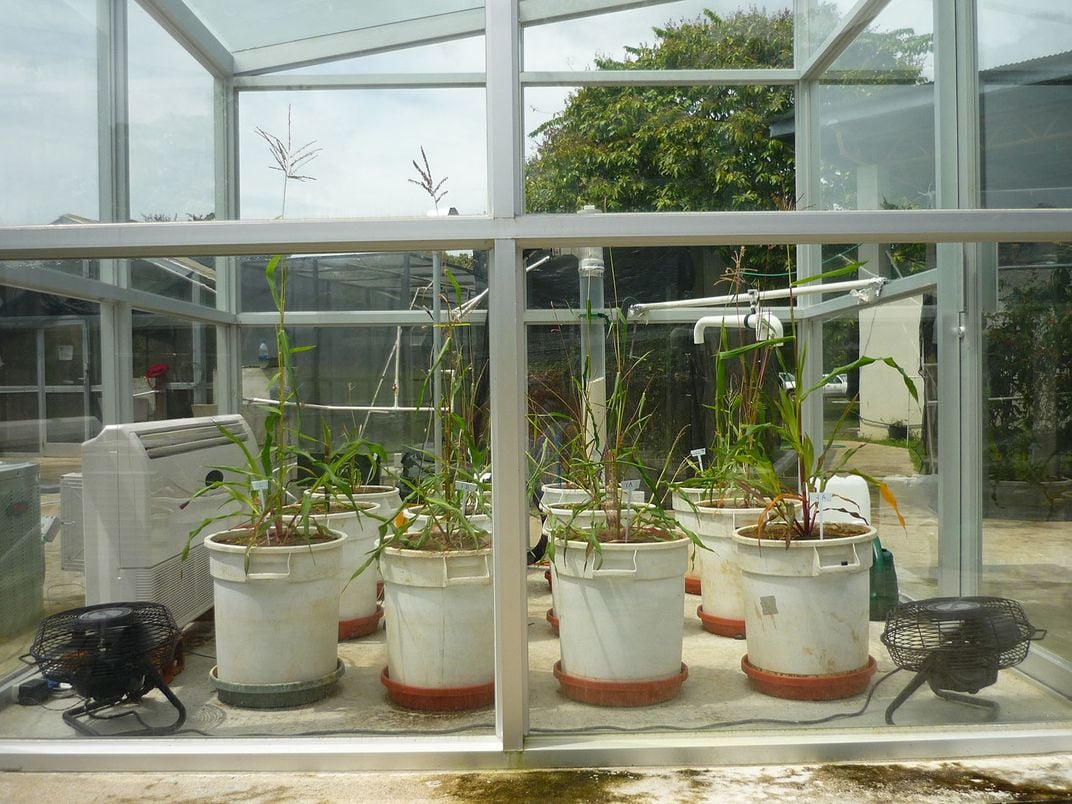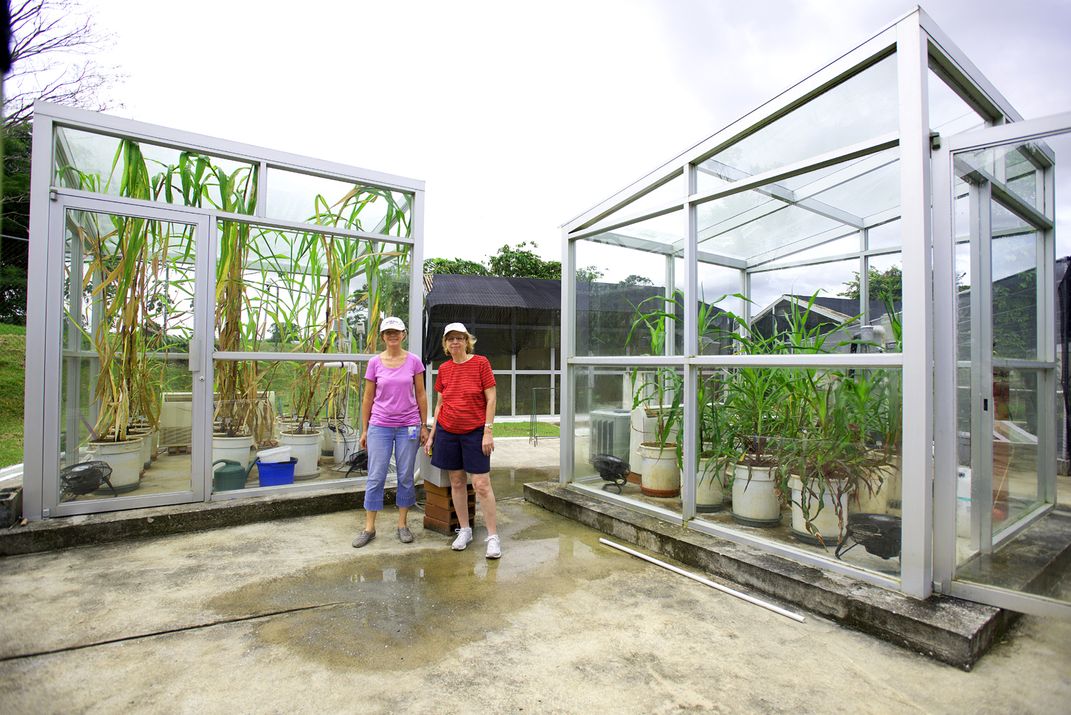To Decode the Mystery of Corn, Smithsonian Scientists Recreate Earth as it Was 10,000 Years Ago
As part of a groundbreaking study, researchers built a greenhouse “time machine”
:focal(1021x221:1022x222)/https://tf-cmsv2-smithsonianmag-media.s3.amazonaws.com/filer/3e/83/3e8366e5-73a7-4fab-9b39-6e233364698f/stri_tesosinte2_nov_2013_seanmattson.jpg)
Corn, a crop that is farmed on every continent except for Antarctica, looks very little like its ancestor, a wild grass with hard kernels that grows today in southwestern Mexico and is called teosinte.
Botanists have debated for nearly a century over the origin of corn, believing at one point that the modern plant was descended from an extinct wild maize, or something yet undiscovered. Geneticists, however, eventually determined in 1990 that corn was related to hard-kernelled teosinte, and concluded that the plump, juicy plant we know today is the domesticated form of the wild grass. Between 10,000 and 13,000 years ago, scientists reasoned, farmers had selected and planted the seeds with favorable traits and over time the plant was transformed.
But in a study published last week in the journal Quaternary International, Smithsonian researcher Dolores Piperno, an archaeobotanist working at the Smithsonian Tropical Research Institute’s field station in Gamboa, Panama, shared a new “time machine” hypothesis. Under past environmental conditions, she and her colleagues say, teosinte looked far different than it does today and more closely resembled modern-day corn than it does now. This may shed light on why early farmers chose to cultivate it.
/https://tf-cmsv2-smithsonianmag-media.s3.amazonaws.com/filer/cc/2a/cc2a3a3f-d03d-49a0-aede-ce957bfde2eb/piperno_with_teosinte.jpg)
“We know that between 10,000 and 13,000 years ago,” says Piperno, “when hunter-gatherers first started exploiting the wild ancestors of [today’s] crops and when the first farmers actually started cultivating the crops, temperature and atmospheric CO2 were very different.”
Piperno worked with Klaus Winter, who designed a glass-chambered greenhouse—the time machine—maintained with lowered CO2 levels and kept at lower temperatures that were similar to those of the late Pleistocene and early Holocene periods. For control purposes another greenhouse that mimicked today’s environment was readied nearby. Piperno and her colleagues then planted teosinte in both chambers.
It was while studying corn’s fossil history and past environmental conditions that Piperno began to wonder what the plant’s ancestors might have looked like during the late-Pleistocene and early Holocene, when they were first harvested and then cultivated. Back then, the temperature was 3.5 to 5.4 degrees cooler than it is today, and atmospheric CO2 hovered at levels around 260 parts per million. Later, during the Industrial Revolution, CO2 would rise to today’s 405 parts per billion, the level in which the tall, long-branched teosinte plant now grows.

Piperno was interested in studies examining how future CO2 and temperature increases might induce something called “phenotypic plasticity,” or changes in the appearances in the plant in response to its environment. Phenotypic plasticity can cause two genetically identical organisms to look different if grown in separate conditions.
In the “time machine,” Piperno and Klaus were intrigued to find that the teosinte plants grew to more closely resemble the corn that we grow and eat today. While today’s teosinte has numerous tasseled branches with ears growing on secondary branches, the greenhouse plants had a single main stem topped by a single tassel, as well as several short branches with ears. And the seeds were different, too: unlike wild teosinte seeds, which matured sequentially, all the seeds in the experimental plants matured all at the same time, similar to corn kernels, or seeds. Today’s teosinte seeds are enclosed in tight vegetative bracts, but the time-machine produced plants with seed kernels that were exposed.
According to Piperno, fewer branches, along with easily visible seeds, would’ve made teosinte an easier crop to harvest. These characteristics–previously thought to have stemmed from human selection and domestication–might have been spurred through environmental changes that induced phenotypic plasticity.

It looks like the environment played a “significant, if serendipitous” role in the focus on teosinte for cultivation, Piperno says. Maize-like features “gave early farmers a head start.”
Daniel Sandweiss, a professor of Anthropology and Quaternary and Climate Studies at the University of Maine, has conducted extensive research on early climate change in Latin America. He called Piperno’s experiment “groundbreaking,” and said he believed it would “become a model for a whole series of studies.”
Piperno, Klaus and their team were also interested in seeing how a noticeable spike in temperature and CO2 that occurred between the late Pleistocene and Holocene eras may have influenced plant productivity, and could help to explain a possible reason for why agriculture began during that time and not before.
During the Pleistocene, atmospheric CO2 levels were even lower than they were during the Holocene–at least by one-third–and the temperature was 5 to 7 degrees cooler. Pleistocene era CO2 levels and temperatures were limiting factors on plant growth, concluded Piperno, who’d seen previous research suggesting that growing plants in a low CO2, low-temperature environment inhibited photosynthesis and lowered seed yield.

Piperno’s own results echoed prior studies; teosinte also formed more seeds in the chamber with warmer temperature and increased C02. This phenomena perhaps made agriculture, for the first time, a sustainable practice to feed families. The plant’s increased productivity, says Piperno, turned farming into “a good adaptive strategy.”
“The results are startling,” says Sandweiss, who noted that teosinte’s appearance had long stymied scientists. After seeing what teosinte looked like in Pleistocene growth conditions, its relation to corn began to “make a lot more sense.”
Piperno’s experiment might also help scientists and archeologists understand the process and timing of crop domestication across the globe, noted Sandweiss. Wheat, barley and rice might’ve also experienced phenotypic changes and increased productivity in the late Pleistocene and early Holocene eras. Tracing this process might explain, “as it seems to with corn, why people chose those particular species and not others, and why the process of domestication took place when it did.”
Piperno plans to continue her research by conducting artificial selection studies, growing several generations of plants to observe the inheritance of the induced, maize-like phenotypes. She says that phenotypic plasticity is becoming an important part of what scientists call “the new modern synthesis” – broadening how scientists view the environment’s effect on evolutionary change.
“We’ve basically opened a window,” says Piperno.
/https://tf-cmsv2-smithsonianmag-media.s3.amazonaws.com/accounts/headshot/Fawcett-Bio.jpg)
/https://tf-cmsv2-smithsonianmag-media.s3.amazonaws.com/accounts/headshot/Fawcett-Bio.jpg)